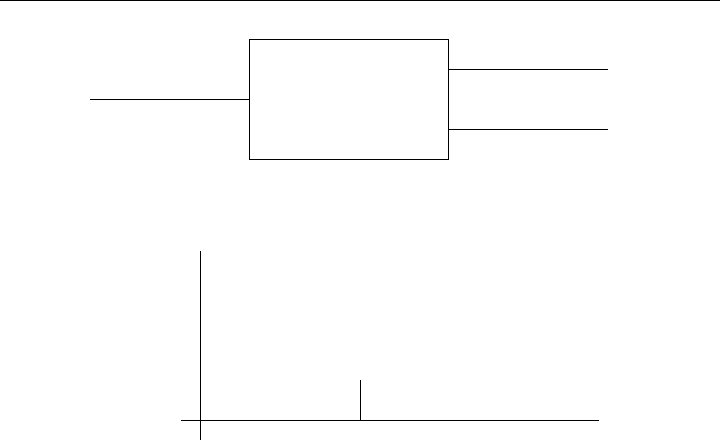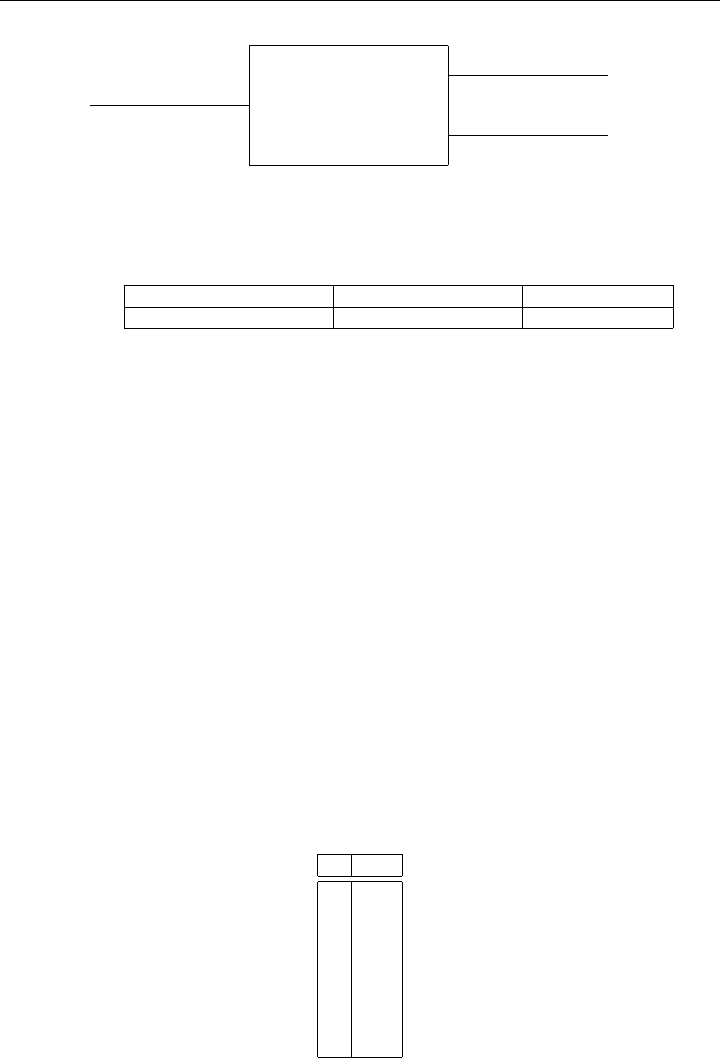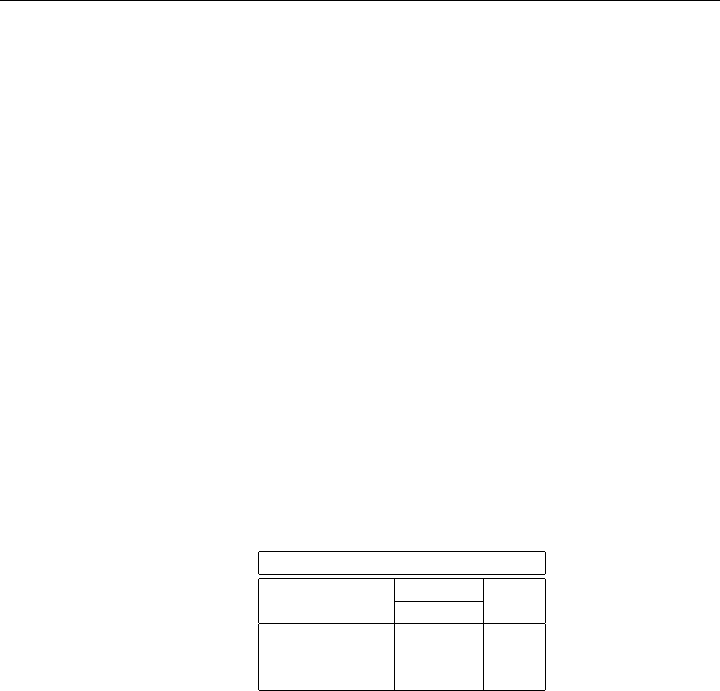Dantzig G., Thapa M. Linear programming. Vol.1. Introduction
Подождите немного. Документ загружается.


162 EQUIVALENT FORMULATIONS
6.8 NOTES & SELECTED BIBLIOGRAPHY
Goal Programming is a special case of solving multiple objectives in general. Additional
information on goal programming can be found in Davis & McKeown [1981], Hillier &
Lieberman [1995], Ignizio [1976], Lee [1972], Murty [1983], and Steuer [1985]. For ap-
plications of goal programming to financial management see, for example, Sponk [1981].
Techniques for formulating linear programs in practice can be found in Bradley, Hax, &
Magnanti [1977], Shapiro [1984], and in Tilanus, DeGans, & Lenstra (eds.) [1986].
Curve fitting is used extensively, especially in statistical applications. In statistics, the
method described in Section 6.6 is referred to as least-squares or multiple linear regression.
Many excellent references are available, for example, Chambers [1977], Feller [1957, 1969],
Kennedy & Gentle [1980], and Mood, Graybill, & Boes [1974]. See Linear Programming 2
for a discussion on the use of the QR factorization to solve the linear least-squares problem.
The proof of Exercise 6.1 is originally due to Tucker (see, Dantzig [1963]). Problem 6.10
on page 165 introduces the concept of a fixed charge problem, see Dantzig & Hirsch [1954].
Problem 6.12 on page 166 briefly introduces the concept of game theory, the mathematical
formulation of which can be found in Borel [1921, 1924, 1927], von Neumann [1928, 1937,
1948a, 1953], and in the now famous book Theory of Games and Economic Behavior by
von Neumann & Morgenstern [1944].
6.9 PROBLEMS
6.1 Consider the following linear program:
Minimize −2x
1
+ x
2
+ x
3
= z
subject to x
1
+ x
2
+ x
3
=4
2x
1
− x
3
≥ 3
−∞ ≤ x
1
≤∞,x
2
≥ 0,x
3
≥ 0.
(a) Replace the variable x
1
by the difference of two nonnegative variables and
solve the resulting linear program by hand.
(b) Solve the linear program using the DTZG Simplex Primal software option.
6.2 Formulate the following problem as a linear program in standard form:
Minimize x
1
− 3x
2
+ x
3
− x
4
= z
subject to x
1
− 2x
2
− 3x
3
+ x
4
≤ 10
2x
1
+ x
2
+ x
3
− 2x
4
≤ 6
x
1
,x
2
unrestricted,x
3
≥ 0,x
4
≥ 0.
(a) Replace each of the unrestricted variables x
1
and x
2
by the difference of
two nonnegative variables and solve the resulting linear program by hand.
(b) Solve the linear program using the DTZG Simplex Primal software option.

6.9 PROBLEMS 163
6.3 Formulate the following problem as a linear program and solve it using the DTZG
Simplex Primal software option.
Minimize 2|x
1
| +3x
2
+4x
3
= z
subject to x
1
+ x
2
+2x
3
≤ 8
2x
1
− x
2
+ x
3
≥ 4
x
1
unrestricted,x
2
≥ 0,x
3
≥ 0.
6.4 Formulate the following problem as a linear program and solve it using the DTZG
Simplex Primal software option.
Minimize −6x
1
− 8x
2
− 5x
3
− 4x
4
= z
subject to 3x
1
+3x
2
+8x
3
+2x
4
=50
|2x
1
+3x
2
+2x
3
+2x
4
|≤20
x
j
≤ 40, for j =1,...,4.
What happens if the bounds x
j
≤ 40 are dropped.
6.5 Where possible, reformulate the following problems as linear programs in stan-
dard form, min c
T
x, Ax = b, x ≥ 0.
(a)
Minimize c
T
x = z, with c>0
subject to x
j
= max(u
j
,v
j
),j=1,...,n.
(b)
Minimize c
T
x = z
subject to A
1
x ≥ 0
A
2
x ≤ 0.
(c)
Minimize c
T
x = z
subject to Ax = b
x ≥ 0
x
j
integer for j =1,...,n.
(d)
Minimize c
T
x = z
subject to Ax = b
x ≥ 0
x =0.
6.6 Excesses and Shortages. Problems that occur in practice often have costs as-
sociated with coming below or exceeding certain requirements. For example, if
production of an item is below the contracted amount, a shortage cost is in-
curred either because of the contract stipulation or because the demand is met
by having to buy the item from an expensive outside source. On the other hand,
if production exceeds the demand, then a holding cost is incurred for having to
store the excess production.

164 EQUIVALENT FORMULATIONS
Suppose that your company manufactures n different items x
j
, each of which
can be sold at a unit profit of p
j
. Assume that the production constraints are
Ax = b. Except for item 1, assume that all other items, x
2
,x
3
,... ,x
n
, can
be sold easily on the open market. Suppose that your contractual agreements
are such that you must deliver d
1
units of item 1. If you are unable to deliver
exactly d
1
units of item 1, a penalty cost, or shortage cost, of s is incurred. On
the other hand, in the hopes of selling item 1 in the next time period, if you
produce more than the demand, you incur a holding cost, or excess cost, of e.
Develop a linear programming model to maximize profit. Clearly state the
conditions under which the linear programming model succeeds in solving this
problem.
6.7 Use the DTZG Simplex Primal software to find the maximum of the minimum
value of x
j
for j =1,...,3 that satisfy the system of inequalities
2x
1
+ x
2
+2x
3
≤ 15
x
1
+3x
2
+4x
3
≤ 25
3x
1
+ x
2
+5x
3
≤ 30
x
j
≥ 0,j=1, 2, 3.
6.8 Use the DTZG Simplex Primal software option to find the maximum of the
minimum value of x
j
for j =1,...,3 that satisfy the system of inequalities
2y
1
+ y
2
+3y
3
≥ 5
y
1
+3y
2
+1y
3
≥ 10
2y
1
+4y
2
+5y
3
≥ 20
y
j
≥ 0,j=1, 2, 3.
6.9 Optical Scanning Problem (Avi-Itzhak, H., Van Mieghen, J., & Rub, L. [1993]).
An optical scanner compares the preprogrammed pattern of each letter, de-
scribed by a matrix of pixels 50 × 50 = 2500 recorded as a 2500 dimensional
vector normalized to be of unit length, with that of an unknown letter observed
by scanning a matrix of pixels 50 ×50 = 2500. The unknown letter described by
the vector x will be said to be the same as the preprogrammed letter described
by the vector a if the correlation
a
T
x
||x||
≥ k,
where k is a constant typically chosen to be greater than say 0.95.
(a) Suppose that you are designing software for a scanner to be used to differen-
tiate between the several kinds of letters of an alphabet and the typefaces of
each letter. Then each unknown would need to be compared with several
preprogrammed versions of each letter, which unfortunately turns out to
take too long to do and requires too much storage. Instead, we would like
to use some sort of average representation of each letter in order to reduce
the processing time and storage. If we let a
i
= A
i•
, i =1,...,m, represent
m different representations of a given letter, then we might be interested in
choosing as the “average” representation of typefaces of a letter as β = β
∗
,
of unit length, that maximizes the minimum correlation:
ρ = max
β
min
i=1,...,m
A
i•
β
||β||
, ||β|| =1. (6.23)

6.9 PROBLEMS 165
Show that this is equivalent to solving the following quadratic program (i.e.,
an optimization problem where the objective function is a quadratic and
the constraints are linear):
Minimize y
T
y = z
subject to A
i•
y ≥ 1,i=1,...,m,
(6.24)
and setting β = y/||y||. Hint: Show that (6.24) is equivalent to finding β
that solves
Maximize ρ = u
subject to ρ ≤
A
i•
β
||β||
,i=1,...,m.
(b) If software for solving a quadratic program is unavailable, show how you
can apply piecewise linear approximations to solve the quadratic program
(6.24) approximately as a bounded variable program. Hint: Show that y
T
y
is a separable quadratic form.
6.10 Fixed Charge Problem. In many practical applications there is the underlying
notion of a fixed charge. For example, a refinery may want to know whether
building an additional refinery would result in better serving the current set of
customers. In such situations the cost is characterized by
c =
αx + β if x>0,
0ifx =0,
where β is the fixed charge.
(a) Show that we may model this by writing the cost form as
c = αx + βy
and including the constraints
y = {0, 1}
and
x − yU ≤ 0,
where U is an upper bound on x.
(b) The inclusion of integer variables in the formulation requires a special-
purpose solver. However, if only one or two variables have an associated
fixed charge, it is possible to use the DTZG Simplex Primal option to solve
the problem. Discuss how you would do this.
(c) Consider the product mix problem of Section 1.4.1. Suppose that manage-
ment has the possibility of a special order on a new desk 5 that requires
12 carpentry hours, 50 finishing hours, and generates a profit of $60. Unfor-
tunately, it requires some additional equipment for finishing purposes and
the cost of this equipment is $500. Should desk 5 be manufactured. What
if the cost of the new equipment was $1,000.

166 EQUIVALENT FORMULATIONS
6
-
54
500
58
Gallons of raw milk
Cost in
cents/gallon
Figure 6-4: Purchase Price of Raw Milk in Region A
6.11 (a) Consider the linear program
Minimize 1x
1
+2x
2
+3x
3
= z
subject to 2x
1
− x
2
+3x
3
=3
0 ≤ x
j
≤ 2, for j =1, 2, 3,
where all variables must take integer values. Show how to convert this to
a binary integer program where all the variables are either 0 or 1 and the
coefficients and right-hand sides are −1, 0, or +1.
(b) Generalize to a linear program where all the variables must take integral
values and all the coefficients and right-hand side are integers.
6.12 Game Theory. In a zero-sum matrix game, the row player, to find his optimal
mixed strategy, must solve the linear program
Maximize L
subject to A
T
x ≥ Le
e
T
x =1,
and the column player, to find her optimal strategy, must solve the linear pro-
gram
Minimize M
subject to Ay ≤ M ˆe
ˆe
T
x =1,
where A is m × n, e =(1, 1,...,1)
T
is of dimension m, and ˆe =(1,...,1)
T
is
of dimension n. Prove that these two programs are duals of each other and
Max L = Min M = v. Note: v is called the value of the game.
6.13 Ph.D. Comprehensive Exam, September 23, 1972, at Stanford. Happy Milk
Distributors (HMD) purchases raw milk from farmers in two regions: A and
B. Prices, butterfat content, and separation properties of the raw milk differ
between the two regions. HMD processes the raw milk to produce cream and
milk to desired specifications for distribution to the consumers.
Region A Raw Milk. The purchase price in 1972 dollars of raw milk in Region
A is indicated in Figure 6-4. For example, to purchase 700 gallons would cost
54(500) + 58(200) cents. There is no upper bound on the amount that can be
purchased. Raw milk from Region A has 25% butterfat and when separated (at

6.9 PROBLEMS 167
Separation of
Region A Milk
-
Raw Milk
15% butterfat
-
Milk
41% butterfat
-
Milk
12% butterfat
Figure 6-5: Separation of Region A Milk
6
-
38
700
42
Gallons of raw milk
Cost in
cents/gallon
Figure 6-6: Purchase Price of Raw Milk in Region B
5 cents per gallon) yields two “milks,” one with 41% butterfat and another with
12% butterfat; this is shown in Figure 6-5. The volume of milk is conserved in
all separation processing.
Region B Raw Milk. The purchase price in 1972 dollars (as for Region A raw
milk) is illustrated in Figure 6-6. Raw milk from Region B has 15% butterfat
and when separated (at 7 cents per gallon) yields two “milks,” one with 43%
butterfat and another with 5% butterfat; this is shown in Figure 6-7. The
volume of milk is conserved in all separation processing.
Production Process. After the milk is purchased and collected at the plant, it is
either mixed directly or separated and then mixed. Mixing, to produce cream
and milk to specifications, is done at no cost. For example, some of the raw
milk from Region A may be separated and then mixed, and some of it may be
mixed directly (i.e., without having been first separated).
Demand and Selling Price. The demand and selling price are described in Ta-
ble 6-2. For example, all the cream produced must have at least 40% butterfat;
it sells at $1.50 per gallon; no more than 250 gallons of the cream produced can
be sold.
The Problem. Assuming disposal is free, formulate a linear program that when
solved on a computer would enable HMD to maximize its profits.
6.14 Vajda [1961]. Suppose that you visit the racecourse with B dollars available
for betting. Assume further that there is only one race on this day and that N
horses are competing. The betting works as follows: If you bet one dollar on
horse k, then you get α
k
> 0 dollars if it comes in first and 0 dollars otherwise.
Formulate a linear program to determine how much of a total of B dollars should

168 EQUIVALENT FORMULATIONS
Separation of
Region B Milk
-
Raw Milk
15% butterfat
-
Milk
43% butterfat
-
Milk
5% butterfat
Figure 6-7: Separation of Region B Milk
Minimum required
percentage of butterfat
Maximum volume
demanded in gallons
Selling price in
cents per gallon
Cream 40 250 150
Milk 20 2000 70
Table 6-2: Demand and Selling Price of Milk
you bet on each horse so as to maximize the minimum net gain, irrespective of
which horse comes in first.
6.15 (a) Solve Problem 6.14 for N =2,α
1
=1,α
2
= 2, and B =1.
(b) Observe that the bets are inversely proportional to α
1
and α
2
. Prove that,
in general, the optimal solution is to bet inversely proportional to the return
onabetα
k
. Hint: Show that the bets x
j
, for j =1,...,N, must be basic
variables in an optimal solution and that they price out as optimal.
6.16 Suppose an experiment results in the data points shown in Table 6-3. It is
hypothesized that the relation is a cubic of the form
y = x
0
+ x
1
t + x
2
t
2
+ x
3
t
3
.
Find the parameters x
0
, x
1
, x
2
, x
3
that give the best fit to the data. Solve
the problem using each of the three models described in this chapter. (Note:
For the least squares problem, simply set up and solve the normal equations
A
T
Ax = A
T
b.)
6.17 Davis & McKeown [1981]. Sigma Paper Company, Inc., is about to build a new
plant. The labor requirements to build the plant are 2,000 nonprofessionals and
t y
1 6
2 18
3 50
4 101
5 177
6 296
7 447
8 642
Table 6-3: Experimental Points for a Cubic

6.9 PROBLEMS 169
850 professionals. Because of labor market shortages in both categories, costs
for recruiting women and minorities are greater than for others. Specifically,
the cost for recruiting minorities (men or women) is $740 for nonprofessionals
and $1,560 for professionals. For recruiting nonprofessional women the cost
is $850 and for recruiting professional women the cost is $1,450. Otherwise
the recruiting costs for men average $570 for each nonprofessional position and
$1,290 for each professional position. The company has budgeted $2.4 million
for recruiting purposes, and the management has established the following goals
in order of priority.
Goal 1: At least 45% of the new labor force should be women.
Goal 2: Minorities should constitute at least 40% of the labor force. Fur-
thermore, a minority woman is counted both as a minority and
as a woman employee.
Goal 3: The cost of recruiting should be minimized.
Goal 4: The recruiting cost should be limited to $300,000.
(a) Use the goal programming technique to formulate a linear programming
model for this problem.
(b) Solve the problem using the software provided with the book.
6.18 Adapted from Hillier & Lieberman [1995]. Consider a preemptive goal program-
ming problem with three priority levels, one goal for each priority level, and just
two activities to contribute towards these goals as shown in the table below:
Unit Contribution
Activity
Priority Level abGoal
One 12≤ 20
Two 11=15
Three 21≥ 40
(a) Use the goal programming technique to formulate a linear programming
model for this problem.
(b) Solve the problem using the software provided with the book.
(c) Use the logic of preemptive goal programming to solve the problem graph-
ically by focusing on just the two decision variables. Clearly explain the
logic used.
(d) Use the sequential programming technique to solve this problem with the
software provided with the book. After using the goal programming tech-
nique to formulate the linear programming model at each stage, solve the
model graphically by focusing on just the two decision variables. Identify
all optimal solutions obtained for each stage.
6.19 Use the weighted goal programming method to solve Problem 6.18.
6.20 Estimate the failure rate x
i
of an item as a function of its age i. An experiment
is run with K new items put in use at time 0. Time is divided into unit intervals
and the number still working at the beginning of each interval is observed. If
we let f
i
be the number of items observed to be working at the start of time
interval i, then f
i
−f
i+1
are the number of items that failed during time interval i

170 EQUIVALENT FORMULATIONS
and a
i
=(f
i
− f
i+1
)/f
i
is the observed failure rate at the age of i time units.
Suppose that from engineering considerations we know that the failure rate in
a large population increases with age; this is the Increasing Failure Rate (IFR)
property. The actual failure rates in the experiment with only K items may not
be increasing due to random fluctuations in the observations. The solution x
to the problem is required to satisfy the IFR property and at the same time be
one that is closest to the observed failure rates a in the sense of minimizing the
maximum absolute values of the difference. Formulate this problem.
6.21 Ubhaya [1974a, 1974b] in Murty [1983]. Let w =(w
1
,w
2
,... ,w
n
)
T
> 0, a
vector of positive weights, be given. For each vector y ∈
n
, define the function
L(y)by
L(y) = max {w
i
|y
i
| : i =1,...,n}.
Given a vector a ∈
n
, formulate a linear program to find a vector x ∈
n
to
Minimize L(a − x)
subject to x
i
− x
i+1
≤ 0,i=1,...,n− 1.
(a) Show that this is a generalization of Problem 6.20, where we have attached
weights w
i
to the deviations.
(b) How does the formulation change if, in addition, each x
i
is required to be
nonnegative, and also less than or equal to one?
(c) Solve the problem for n =3,w =(0.3, 0.6, 0.1)
T
, and a =(0.20, 0.45, 0.35)
T
.
6.22 Solve the calculus problem
Minimize x
2
1
+ x
2
2
+ x
2
3
+2x
1
+4x
2
+8x
3
= z
subject to x
1
+ x
2
+ x
3
=6
by using linear programming software and piecewise continuous linear approx-
imations to the quadratic functions (with upper and lower bounds on the vari-
ables introduced to make the approximations). What properties of the approx-
imates ensures the convexity of the approximations.
6.23 Consider the following problem, which has a convex objective function and linear
inequality constraints
Minimize x
2
1
+2x
2
2
= z
subject to 4x
1
+5x
2
≤ 20
x
1
+ x
2
≥ 2
Solve the problem using piecewise continuous linear approximations to the con-
vex function. Use 4, 8, and 12 pieces. Compare the results under the different
approximations.

CHAPTER 7
PRICE MECHANISM AND
SENSITIVITY ANALYSIS
The term sensitivity analysis, sometimes called post-optimality analysis, refers to
an analysis of the effect on the optimal solution of changes in the input-output
coefficients, cost coefficients, and constant terms. Such analysis can often be more
important in practice than finding the optimal solution. It is a very important part
of solving linear programs in practice. Most practical problems have input data
whose values are not known with certainty. For example, the costs of raw materials
may change after the model is solved, or the costs used in the model may only be
a guess as to what they will be in the future; the right-hand-side constraints may
have to be changed because more or less of the resources are available in the market
than previously estimated or were earlier authorized by management to buy; or
the coefficients may have to be changed because product specifications have been
changed.
In addition to the optimal tableau giving us the point of most profitable op-
eration, it is possible to obtain from it a wealth of information concerning a wide
range of operations in the neighborhood of this optimum by performing a sensitivity
analysis. As noted, in many applications, the information obtained is often more
valuable than the specification of the optimum solution itself.
Sensitivity analysis is important for several reasons:
1. Stability (robustness) of the optimum solution under changes of parameters
may be highly desirable. For example, using the old optimum solution point;
a slight variation of a parameter in one direction may result in a large unfavor-
able difference in the objective function relative to the new minimum, while
a large variation in the parameter in another direction may result in only a
small difference. In an industrial situation where there are certain inherent
171
